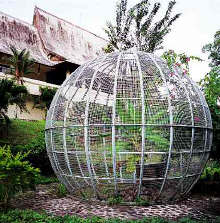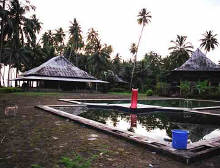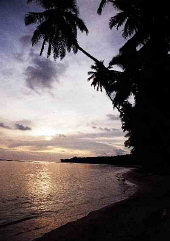Strange Days in Nias
Nias, Indonesia
I first discovered Nias in a guidebook that described the island as one of the last strongholds of intact Megalithic culture. So when my parents decided to visit my husband and I in Jakarta, and take us on a tour of Sumatra, we couldn’t resist adding Nias to the itinerary. The fact that the guidebooks mentioned a “3-star” hotel on the island, complete with TVs and fridges in the rooms, seemed like an added bonus. We could have our adventurous trip, yet stay in modern comfort.
To be honest, I had mixed feelings about booking a stay in a “luxury” hotel in Nias. Although the ease appealed, my travels elsewhere in Indonesia, especially Bali, made me question the impact of large-scale tourist development. But in the end, hesitant to put my American parents in a backpacker guesthouse, I opted for the hotel.
Off the western coast of Sumatra, Nias is a small but beautiful island, with rugged green hills and palm-lined coasts. It’s most famous for the waves off the southern beaches at Teluk Dalam and Lagundri, which attract surfers from around the world. But we were visiting in January, when the seas are calm and the surfers absent.
I knew it was not exactly high tourist season, especially since it was just a few months after the Bali bombing.
A travel agent in Medan booked us into the Sorake Beach Hotel, near Teluk Dalam. He warned us that he hadn’t sent any clients to Nias in over two years, so he couldn’t vouch for the facilities. I wasn’t too concerned, assuming the surfer trade kept the hotel busy a few months a year.
We took an early morning flight from Medan, on an 8-passenger flight. A friendly guide named Yono picked us up with a brand-new minivan at the tiny airport in the north of the island, and took us to a nearby village to see some of the island’s distinctive traditional houses. Then we embarked on a bone-rattling six hour drive along the coast to the southern part of the island. None of us minded the deplorable road conditions much, as there was so much to see along the way: village after village of wood and thatch huts, naked children in streams, rice and spices drying along the mostly empty road, beaches lined with fishing boats.


An empty globe on the grounds of the hotel
![]()
![]()
At last, in the late afternoon we pulled into the Sorake Beach Hotel. At first sight, things looked fine. There was a large, open main building with some ethnic-looking decorations. But as I stood waiting for my father to check in, I slowly realized the lobby was almost completely bare. Nevertheless I was optimistic, thinking the lobby bar would be opening up in just a couple hours.
A bellboy led us to our rooms, which were large wooden bungalows on stilts designed to look like traditional Nias houses. They were in fair condition from the outside, but there was quite a lot of plant-life on the roofs. Our room was reasonably nice inside, though it felt rather worn. There was no TV, and the toilet was rusty. I flipped the switch for the fan and nothing happened.
We went outside to walk around the grounds, and on the way out of our bungalow we saw the woman who had checked us in and asked her about the electricity. She told us that the electricity was only on between 6 p.m. and 8 a.m.
That was the first shock. It was unbearably hot and humid, as bad as steamy Jakarta, and I wasn’t psychologically prepared not to have even a fan during the daytime.
It didn’t take much meandering around the grounds for us to realize the Sorake Beach Hotel was pretty much abandoned. The pool was a vivid green color, filled with algae blooms and other water plants. The restaurant was completely closed, with all its furniture cleared out, and the grounds were overgrown. There was trash scattered around on the grass, from the staff’s own New Year’s party a few days ago, we guessed. Toward the beach, someone was burning a massive pile of garbage and rotting palm fronds. We walked around some of the guest bungalows at the back of the hotel, but they were nearly all closed up. A few looked occupied, by staff most likely, and had chickens scratching underneath.
I still had hopes for the beach, but they were soon dashed. It was a tiny stretch of sand, covered with ocean debris. The water was shallow but rocky. My husband Robert was willing to brave a dip, but came across broken bottles among the rocks. We took in the sunset, amid derelict beach chairs and bottle caps.
Returning to our bungalow, we noticed we had a neighbor. A Japanese surfer looked perfectly content, reading on his porch. He was the only other guest, unless you include the villagers who strolled through the grounds now and again.
Our guide Yono soon appeared to inform us that since the hotel restaurant was not functioning, we would walk to a nearby restaurant for dinner. We asked if there was a place in the hotel to buy water or snacks, since we were already thirsty, and he said no.
By this time, my mother was freaking out. I should mention that my parents are fairly experienced travelers, and had visited me in Indonesia when I was an exchange student in East Java in 1990. But my mother has a bit of a taste for luxury and likes her amenities. She was practically hyperventilating when we came back from the beach. She was demanding that we leave right away or the next morning. But the travel agent hadn’t been able to book a return flight, as all the flights were full for the next few days. Instead, we were scheduled to take a boat back to Sumatra in a few days time. There was no other way to get off the island.
Seeing she was in an unreasonable mood, we left my parents to their own devices and went back to the beach. When we returned, she had calmed down a bit, and was beginning to see the absurdity of the situation. The four of us sat on the bungalow porch and snacked on some cookies we had luckily bought before the long ride south.


The Sorake Beach Hotel’s murky pool
![]()
![]()
At last it was time for dinner. Yono reappeared and we walked to a restaurant down the road from the hotel. The hotel’s surrounding fence was broken, so we didn’t have to go all the way back through the empty lobby and the long driveway. A few minutes walk down the road was a small strip of losmens (the Indonesian term for a small guesthouse), a few battered signs for restaurants, and some houses with tiny stalls selling water, beer, soda, and crackers. All except the snack stalls looked closed, but we turned into one building that had a large restaurant.
In high surf season, assuming there still is one, the restaurant has a prime location across from the surf judging platform on Lagundri beach. Needless to say, it was empty, but Yono was able to drum some life out of the kitchen. We kept the order simple, hoping they could prepare grilled fish and stir-fried vegetables. We sat at a table and a waiter brought us some Cokes and beers. The meal was cheap and decent, and Yono told us we could eat here while we stayed at the hotel, as long as we ordered in advance.
It was pitch black by the time we returned to the bungalow. At least the electricity was on, so we could cool down the room with the fan. With no restaurant, bar, or television, there wasn’t much to do but read. As we got ready for bed, we found the water wasn’t working. No tooth-brushing or face washing for us.
I slept pretty well that night, though I was paranoid about all the strange people roaming the hotel grounds. After the nearly full moon rose, it wasn’t very dark outside, and I fully expected to awaken and see a person standing on the porch, staring at us through the broken blinds.
The next morning Yono met us and we climbed into the red minivan for our day tour of southern Nias villages. This part of the trip went smoothly – the villages were as unusual and strange as I had hoped, the surroundings gorgeous. We wandered through villages of boat-shaped houses, made of wood and bamboo, raised high above the ground, without a single nail used in their construction. Enigmatic, centuries-old stone stairways, tables, chairs, and carved statues lent a mysterious feel to many places. We encountered no other travelers, though the guidebook had warned about large groups descending on the villages. I wondered when that was, exactly. In one village, I signed a guest book at a house said to have been the former king’s palace. The previous signature was from a South African visitor in July 2000. No wonder the village children practically rioted at the sight of us.
I had seen postcards of the celebrated stone jumpers of Nias, young men who leap over six foot high megalith stones. But when I asked about this, Yono said it cost $100 to see a ceremony.
We arrived back at the hotel in the late afternoon, dreading the prospect of the water still being off. As expected it wasn’t working, so we resorted to bathing from a bucket of water. I shampooed my hair, trying to use as little water as possible so there would be enough left for my husband. I felt slimy, grimy, and incredibly thirsty.
In the meantime, Robert had been walking around the bungalows and found a guy who claimed to be the night manager. The night manager was friendly, and explained that there were only about 10 people on staff now, down from dozens. He said that the heyday of the Sorake was in the mid-1990s, and that it had been built with government investment to boost tourism on the island. That was also when the tour groups arrived; villagers eagerly sold them ‘antiques’ and charged them exorbitant sums for traditional dances. But tourism declined precipitously after the 1997 economic crisis, and never quite bounced back. The yearly surf competition didn’t help the Sorake much, because most of the surfers stayed at losmens or on boats anchored offshore. It seemed that the Sorake had limped along until early 2001; gradually the staff was laid off, bungalows closed and the furniture sold off. Most recently the electricity was turned off during the day because it was simply too expensive. But the water hadn’t been turned off, he insisted, it was truly just a broken pump.
That evening we had exactly the same dinner as before at the restaurant down the street. At night, I couldn’t sleep, my eyes kept shifting back to the porch with its empty chairs. The next morning, the water was back, and I was so relieved to take a shower. I didn’t care that it was cold. As we ate our cold toast and hot eggs, some local women brought their children to swim in the pool. They didn’t seem to mind the luxurious algae and the vivid color of the water.
We were almost done with Nias. All that remained was to drive to the port to get our boat that evening. We stopped for lunch at a Chinese restaurant outside the main town on the island. Like everywhere else, it was empty, and the high-school age waiter said there had not been a visitor to the restaurant since the Bali bombing. I got Yono to admit that when his local tour company gets the occasional traveler or two, it never books people into the Sorake, but runs its own losmen.
In the vacant restaurant, it was hard to imagine that Nias ever had enough tourism to warrant a major development like the Sorake. But whether or not it was warranted probably didn’t matter. The early and mid-1990s were a time when the Indonesian government pushed large-scale tourist developments in remote places like Sulawesi and Biak, in an attempt to market local cultures to the foreign masses. Big developers eager for government money and subsidies built resorts that were mostly vacant within a decade. There was little worry about the effects of tour buses, cameras, and dollars on villages that until recently rarely encountered outsiders. Eager for a new way to make money, villagers happily fulfilled the tourists’ yearning to see authentic traditional cultures. When tourism slowed to a trickle, the big developers simply moved elsewhere, while the villagers were left once again to their own meager resources.


Sunset on the beach in Nias
![]()
![]()
So maybe the surfers were right to stick to the losmens. While the Sorake now slowly rots away, a waste of lovely beach property, the losmens down the street survive by keeping things simple. (They have the advantages of electricity and running water, too.) Maybe this is the kind of development the government should have been nurturing all along.
The story could end here. But Nias had one more surprise for us. It was an exhausting and crowded 14 hour overnight boat ride to Sibolga, on the Sumatran coast. We triumphed over the Indonesian smokers by keeping the window of the stuffy first class section open all night, despite anguished whispers about the cold breeze. And aided by motion sickness pills, we all managed to sleep for several hours. That is, until we were rudely awakened at 6 am by an outburst of ’80s music. The television a few feet in front of us had come to life and was blasting videos by the late, obscure, and un-mourned British band Boney M. When the seemingly endless music documentary mercifully drew to a close, there was a pause, and then it started all over again.